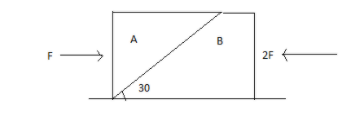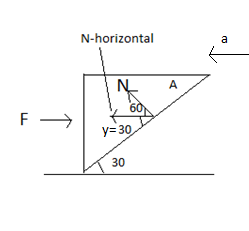
Two blocks (A) and (B) each of mass m are placed on a smooth horizontal surface. Two horizontal forces $F$ and $2F$ are applied on blocks (A) and (B), respectively, as shown in fig. Block (A) does not slide on block (B). Then then the normal reaction acting between the two blocks is (assume no friction between the blocks)

(A) $F$
(B) $\dfrac{f}{2}$
(C) $\dfrac{f}{{\sqrt 3 }}$
(D) $3F$
Answer
218.1k+ views
Hint To solve this question we first find the net force on the system and the net mass. We use these two values in the force formula to get acceleration of the entire system. The acceleration of the entire system is also the acceleration of both the blocks. We now draw a free body diagram of one of the blocks to find all the forces acting on it. Adding all the forces acting on the block and substituting the value of acceleration we found earlier in the formula we find the normal force.
Complete Step by step solution The net mass of the system is the sum of masses of both the blocks.
${m_{net}} = m + m = 2m$
The net force acting on the system is the vector sum of both the forces.
${F_{net}} = 2F - F = F$
From force formula we find the acceleration of the system
$ {F_{net}} = {m_{net}}a $
$ a = \dfrac{{{F_{net}}}}{{{m_{net}}}} = \dfrac{F}{{2m}} $
Since the two bodies don’t slide over one another the acceleration of these two bodies is also the same as that of the entire system.
The free body diagram of the block on the left is

The normal force acting on the block is perpendicular to the $30^\circ $ inclined surface.
Converting into the horizontal direction we get
${N_{Hor}} = Ncos60^\circ $
Here,
${N_{Hor}}$, is the horizontal component of normal force
$N$, is the normal force
The angle between the horizontal and the normal force is $60^\circ $ because from alternate internal angels we get $y = 30^\circ $ degrees and subtracting $90^\circ $ from it we get $60^\circ $ .We subtract $90^\circ $ because the normal force is perpendicular to the surface.
Adding all the forces acting horizontally on block on the left
$Ncos60^\circ - F = ma$
Substituting the value of acceleration $a = \dfrac{F}{{2m}}$
$ Ncos60^\circ - F = m \times \dfrac{F}{{2m}} $
$ \Rightarrow Ncos60^\circ - F = \dfrac{F}{2} $
$ \Rightarrow \dfrac{ N}{2} - F = \dfrac{F}{2} $$(\because \cos {60^ \circ } = \dfrac{1}{2})$
$ \Rightarrow \dfrac{N}{2} = \dfrac{F}{2} + F = \dfrac{{3F}}{2} $
$ \Rightarrow \dfrac{N}{2} = \dfrac{{3F}}{2} $
$ \therefore N = 3F $
Hence normal force is equal to $3F$
Option (D) $3F$ is the correct answer.
Note We can also solve this problem by taking the block on right under consideration. But the normal force for this will be in the opposite direction which then makes the horizontal component of the normal force also become opposite compared to the block on the left. The two normal forces cancel which is why the two blocks are at equilibrium with each other.
Complete Step by step solution The net mass of the system is the sum of masses of both the blocks.
${m_{net}} = m + m = 2m$
The net force acting on the system is the vector sum of both the forces.
${F_{net}} = 2F - F = F$
From force formula we find the acceleration of the system
$ {F_{net}} = {m_{net}}a $
$ a = \dfrac{{{F_{net}}}}{{{m_{net}}}} = \dfrac{F}{{2m}} $
Since the two bodies don’t slide over one another the acceleration of these two bodies is also the same as that of the entire system.
The free body diagram of the block on the left is

The normal force acting on the block is perpendicular to the $30^\circ $ inclined surface.
Converting into the horizontal direction we get
${N_{Hor}} = Ncos60^\circ $
Here,
${N_{Hor}}$, is the horizontal component of normal force
$N$, is the normal force
The angle between the horizontal and the normal force is $60^\circ $ because from alternate internal angels we get $y = 30^\circ $ degrees and subtracting $90^\circ $ from it we get $60^\circ $ .We subtract $90^\circ $ because the normal force is perpendicular to the surface.
Adding all the forces acting horizontally on block on the left
$Ncos60^\circ - F = ma$
Substituting the value of acceleration $a = \dfrac{F}{{2m}}$
$ Ncos60^\circ - F = m \times \dfrac{F}{{2m}} $
$ \Rightarrow Ncos60^\circ - F = \dfrac{F}{2} $
$ \Rightarrow \dfrac{ N}{2} - F = \dfrac{F}{2} $$(\because \cos {60^ \circ } = \dfrac{1}{2})$
$ \Rightarrow \dfrac{N}{2} = \dfrac{F}{2} + F = \dfrac{{3F}}{2} $
$ \Rightarrow \dfrac{N}{2} = \dfrac{{3F}}{2} $
$ \therefore N = 3F $
Hence normal force is equal to $3F$
Option (D) $3F$ is the correct answer.
Note We can also solve this problem by taking the block on right under consideration. But the normal force for this will be in the opposite direction which then makes the horizontal component of the normal force also become opposite compared to the block on the left. The two normal forces cancel which is why the two blocks are at equilibrium with each other.
Recently Updated Pages
Arithmetic, Geometric & Harmonic Progressions Explained

Cartesian Form of Vector Explained: Formula, Examples & Uses

Apparent Frequency Explained: Formula, Uses & Examples

Calorimetry: Definition, Principles & Calculations

Centrifugal Force Explained: Definition, Formula & Examples

Charge in a Magnetic Field: Definition, Formula & Examples

Trending doubts
JEE Main 2026: Application Form Open, Exam Dates, Syllabus, Eligibility & Question Papers

Derivation of Equation of Trajectory Explained for Students

Hybridisation in Chemistry – Concept, Types & Applications

Understanding the Angle of Deviation in a Prism

Understanding Collisions: Types and Examples for Students

How to Convert a Galvanometer into an Ammeter or Voltmeter

Other Pages
JEE Advanced Marks vs Ranks 2025: Understanding Category-wise Qualifying Marks and Previous Year Cut-offs

Units And Measurements Class 11 Physics Chapter 1 CBSE Notes - 2025-26

NCERT Solutions For Class 11 Physics Chapter 8 Mechanical Properties Of Solids

Motion in a Straight Line Class 11 Physics Chapter 2 CBSE Notes - 2025-26

NCERT Solutions for Class 11 Physics Chapter 7 Gravitation 2025-26

Understanding Atomic Structure for Beginners




